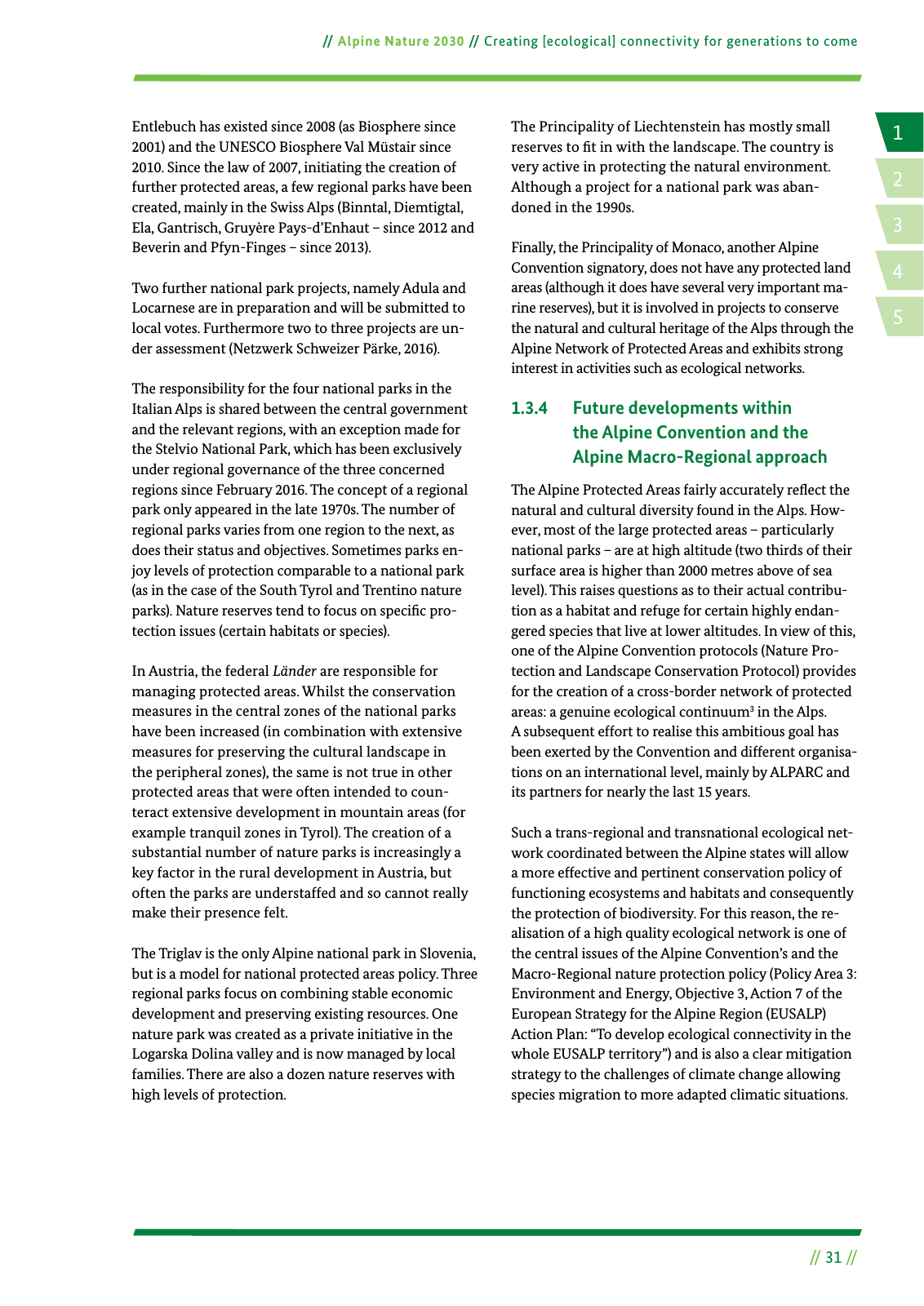14 2 5 3 31 Alpine Nature 2030 Creating ecological connectivity for generations to come Entlebuch has existed since 2008 as Biosphere since 2001 and the UNESCO Biosphere Val Müstair since 2010 Since the law of 2007 initiating the creation of further protected areas a few regional parks have been created mainly in the Swiss Alps Binntal Diemtigtal Ela Gantrisch Gruyère Pays d Enhaut since 2012 and Beverin and Pfyn Finges since 2013 Two further national park projects namely Adula and Locarnese are in preparation and will be submitted to local votes Furthermore two to three projects are un der assessment Netzwerk Schweizer Pärke 2016 The responsibility for the four national parks in the Italian Alps is shared between the central government and the relevant regions with an exception made for the Stelvio National Park which has been exclusively under regional governance of the three concerned regions since February 2016 The concept of a regional park only appeared in the late 1970s The number of regional parks varies from one region to the next as does their status and objectives Sometimes parks en joy levels of protection comparable to a national park as in the case of the South Tyrol and Trentino nature parks Nature reserves tend to focus on speci c pro tection issues certain habitats or species In Austria the federal Länder are responsible for managing protected areas Whilst the conservation measures in the central zones of the national parks have been increased in combination with extensive measures for preserving the cultural landscape in the peripheral zones the same is not true in other protected areas that were often intended to coun teract extensive development in mountain areas for example tranquil zones in Tyrol The creation of a substantial number of nature parks is increasingly a key factor in the rural development in Austria but often the parks are understaffed and so cannot really make their presence felt The Triglav is the only Alpine national park in Slovenia but is a model for national protected areas policy Three regional parks focus on combining stable economic development and preserving existing resources One nature park was created as a private initiative in the Logarska Dolina valley and is now managed by local families There are also a dozen nature reserves with high levels of protection The Principality of Liechtenstein has mostly small reserves to t in with the landscape The country is very active in protecting the natural environment Although a project for a national park was aban doned in the 1990s Finally the Principality of Monaco another Alpine Convention signatory does not have any protected land areas although it does have several very important ma rine reserves but it is involved in projects to conserve the natural and cultural heritage of the Alps through the Alpine Network of Protected Areas and exhibits strong interest in activities such as ecological networks 1 3 4 Future developments within the Alpine Convention and the Alpine Macro Regional approach The Alpine Protected Areas fairly accurately re ect the natural and cultural diversity found in the Alps How ever most of the large protected areas particularly national parks are at high altitude two thirds of their surface area is higher than 2000 metres above of sea level This raises questions as to their actual contribu tion as a habitat and refuge for certain highly endan gered species that live at lower altitudes In view of this one of the Alpine Convention protocols Nature Pro tection and Landscape Conservation Protocol provides for the creation of a cross border network of protected areas a genuine ecological continuum3 in the Alps A subsequent effort to realise this ambitious goal has been exerted by the Convention and different organisa tions on an international level mainly by ALPARC and its partners for nearly the last 15 years Such a trans regional and transnational ecological net work coordinated between the Alpine states will allow a more effective and pertinent conservation policy of functioning ecosystems and habitats and consequently the protection of biodiversity For this reason the re alisation of a high quality ecological network is one of the central issues of the Alpine Convention s and the Macro Regional nature protection policy Policy Area 3 Environment and Energy Objective 3 Action 7 of the European Strategy for the Alpine Region EUSALP Action Plan To develop ecological connectivity in the whole EUSALP territory and is also a clear mitigation strategy to the challenges of climate change allowing species migration to more adapted climatic situations

Hinweis: Dies ist eine maschinenlesbare No-Flash Ansicht.
Klicken Sie hier um zur Online-Version zu gelangen.
Klicken Sie hier um zur Online-Version zu gelangen.